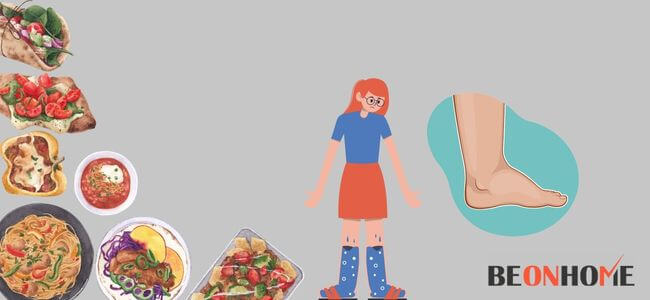We have gradually changed our work styles with time. Due to the current pandemic situation, most people have shifted to work from home method. Usually, when at home, most work is done by sitting in one place. Also sometimes a person ends up sitting for a longer time than required. Unknowingly this creates pressure on the legs.
Therefore people experience swollen feet and ankles. The swollen feet are a result of sitting for long periods. Also keeping your legs hanging without any support could cause it. So, here we are going to discuss the best methods to Prevent Feet Swelling While Sitting On a Desk.
Methods Of Prevention
Quick Navigation
Swelling or Edema occurs due to fluid retention in certain parts of the body. This occurs due to less or no movement or exercise. Swelling can be very painful and difficult to deal with.
Therefore preventing it before it gets to you is the first step. If someone gets swollen feet, they should try to understand what factors might be causing it.
1. Increase Overall Movement
Begin with simple changes in your lifestyle. Exercise and movement during the day will show an effect. Try to not sit in one place for too long. Simple stretching or bending ankles or any other exercise prevents swelling.
The elevation is another practice that can be done. Elevate your leg above the level of heart at the end of a day as an exercise.
This will help to drain excess fluid accumulated due to sitting. Yoga also shows a positive effect and can help in the movement of the body.
Some exercises that you can do every day while sitting to reduce swelling are-
- Extend Your Legs- Sit with your legs flat on the ground and back straight. Extend your legs now and hold them. Now try lifting them when they are fully stretched. Hold it for some seconds and release. You can try alternate leg at a time and repeat for 10-15 times
- Lift Your Knees- First, lift one leg and stretch by bringing it closer to your chest, while the other rests. Now rest this leg and do the same for others. You can repeat it 20 times.
- Ankle Rotation- Lift one leg and just try rotating your ankle. First, rotate clockwise and then anti-clockwise. You can do 10 circles on each side.
- Pump Your Feet- First, keep your toes on the ground and raise the heels as high as possible. Allow it to stretch. Now rest the heels and stretch the toes as much as you can.
2. Maintain Intake Of Salt And Carbohydrates

Salt contains sodium and chlorine. Sodium maintains fluid balance inside and outside of cells by binding to water in the body. When you consume processed food or food rich in sodium, the body tends to retain excess fluid.
This causes swelling. Therefore sodium intake should be reduced to keep swelling in check. Carbohydrates on the other hand lead to an increase in blood sugar levels and insulin levels.
When insulin levels spike in the body. It will retain sodium by increased reabsorption from the kidneys. Sodium, as mentioned above will retain fluid and cause swelling.
Refined carbohydrates should be strictly avoided to decrease swelling. Some of them include processed sugar, table sugars, grains, etc.
3. Use Essential Oils
Essential oils are oils made from concentrated plant extracts. They are also used in aromatherapy where the smell has great health benefits.
Some commonly available Essential oils include-
- Tea Tree Essential Oil– It is known to reduce swelling and inflammation. It is also used in treating bruises or cuts.
- Lavender Essential Oil– Lavender has been proved a strong analgesic. It also helps in suppressing joint pains and reduces swelling.
- Juniper Oil- This has anti-spasmodic properties which can treat spasms due to swelling.
How To Use Essential Oils?
Always use these oils with lighter oil to dilute effects. They can be combined with aloe vera, castor oil, coconut oil, Jojoba oil, almond oil, or wheat oil.
Next, mix the two oils and apply them to your inflamed area gently. Apply it so that it can be absorbed into the skin. This is a way to reduce swelling.
4. Try Magnesium Rich Food:
Magnesium is an important mineral required in the body. It takes part in more than 300 enzymatic reactions throughout the body.
Magnesium intake is known to reduce water retention. Sometimes magnesium deficiency can be the root cause of water retention.
Some magnesium-rich foods can be included in the diet they are:
- Legumes (black beans)
- Nuts (almond, cashew, peanuts)
- Seeds (flax seeds)
- Green vegetables
- Fibre-rich grains
Other than that, magnesium supplements are readily available now. Taking approximately 200 – 400 grams of magnesium per day can help reduce swelling.
5. Increase Potassium And Vitamin B6 Intake
Potassium sends out electrical signals and is also responsible for maintaining heart health. It reduces water retention by decreasing sodium and increasing urine output. Examples of potassium-rich food include bananas and tomatoes.
Vitamin B6 – It is a part of various vitamin groups. It plays a role in red blood formation and also is responsible for other functions in the body. It is known to greatly reduce water retention. Some foods rich in Vitamin B6 are meat, potatoes, walnuts, and bananas.
Hydration – Make sure you drink enough water during the day. Sometimes due to work or other factors dehydration occurs. This might lead to water retention.
Causes Of Swelling

The feet could be swollen due to a lot of reasons. The majority is usually standing or sitting or long periods. If it persists it could be due to an underlying medical condition.
1. Pregnancy
A very common symptom of pregnancy is swelling of the feet and hands. They are noticeable usually between the fourth and fifth months of pregnancy.
They continue till the end of it. This occurs due to fluid retention which increases pressure on the veins.The body during pregnancy retains more fluid than usual. It also produces more bodily fluids.
Tips To Avoid
- Avoid standing for long periods.
- Stay in a cool environment, avoid hot temperatures.
- Wear comfortable shoes, avoid heels.
- Wear compression socks
2. Edema
Edema is the medical term to describe the swelling that occurs due to fluid retention. It majorly affects feet, ankles, and legs but sometimes also the face or abdomen. The part becomes puffy and inflamed.
Symptoms – Shiny or stretchy skin, Discomfort, Low mobility, Walking difficulty.
Treatment – Reduce salt intake
3. Alcohol
Consumption of alcohol is followed by swelling of feet as the body retains more water. It usually subsides after a few hours. If it stays for longer it could indicate an underlying cause.
It could be related to problems with the liver, heart, or kidneys. It could be also due to overconsumption of alcohol.
Here it can be reduced by-
- Increasing water intake and reducing salt intake
- Soaking feet in the water
4. Hot Weather
Sometimes the feet can also swell due to climate conditions. During summers the veins in the body expand to deliver blood in tissues.
This is a natural coping mechanism of the body in the weather. When the veins can’t bring back the blood, water retention occurs. It is also an underlying factor of circulatory diseases.
Tips
- Wear breathable comfortable shoes.
- Do feet exercises
- Soak feet in cool water
5. Ankle Injury
Due to stress on the foot, the ankle may twist causing a sprain. Some ligaments may be stretched and create pressure which causes swelling. The R.I.C.E. treatment is used to treat any injury.
- Rest– Avoid moving and putting pressure on it.
- Ice – This will cool down and bring down swelling.
- Compression – Compression bandages can be used.
- Elevation – keep the foot elevated using a pillow, especially at night.
6. Insufficiency In Veins
This happens due to prolonged sitting or standing. Here the blood cannot flow properly to all parts of the body. This is due to damaged veins and valves. Due to this, the fluid accumulates around the feet.
Symptoms
- Aching in feet
- Textured skin
- Itchy skin
7. Lymphedema
The lymph system comprises an important part of the body. It gets rid of unwanted substances like toxins in the body. Lymphedema occurs due to damaged lymph vessels causing fluid accumulation.
It can also lead to deformity. People who undergo cancer treatments have to remove lymph nodes. Therefore are at a higher risk of developing it.
8. Medication Side Effects
Certain medications also lead to water retention.
Some of the examples are:
- Hormones like testosterone and estrogen.
- Steroids
- Medicines to control diabetes.
What Do You Mean By Swelling Of Feet?
Also called edema, is the accumulation of fluid in the body tissues. Most commonly swelling occurs in the feet, legs, ankles. It can also occur in the hands or abdomen.
It can also spread to the entire body as well. People who sit or stand for long periods or have a sedentary lifestyle tend to have swollen feet.
The swelling symptoms depend on the cause. It varies from person to person and hence people experience different symptoms.
They range from an increase in size without any pain or maybe a change in colour. Some may also experience pus formation. Most feet and ankles swelling can be diagnosed with examination and clinical observation. Later tests can be performed if swelling continues. This could be an underlying cause. Treatments are based on the diagnosis that is obtained. Usually, most swelling go down in some days with light medication.
Complications may arise due to underlying causes or neglected problems earlier. Some complications also lead to severe infections which might require more medical attention.
A medical condition that leads to swelling- Gout – is swelling of joints, leading to redness of the foot and pain. It usually occurs due to arthritis-related problems. X rays, CT scans, and MRI’s can be used to detect extreme cases of swelling.
Foods That May Cause Swelling

Foods that cause swelling are also foods that are bad for your body. Food that is harmful to the body also leads to weight gain. This in turn causes swelling and inflammation.
a. Sugar And Syrups High In Fructose
When there is an intake of sugar, the insulin level is increased. The excess sugar which is not absorbed is stored in fat cells. This causes swelling. Foods with high sugar content are Pastries, Cakes, Sodas, Cereals, etc
b. Refined Carbohydrates
Just like sugars, these also increase blood glucose levels. They then raise the body’s inflammatory response. Foods with refined sugars are Bread, White rice, and French fries.
c. Red Meat And Processed Meat
They are high in saturated fat and cause swelling. Examples of processed meat are hotdogs, Sausages, and Steaks.
d. Vegetable Oils And Seed Oils
Many vegetables, and seed oils contain trans fat which is very lethal for the body. Trans fat holds the capacity to distort the cell membranes.
e. Artificial Trans Fat
It is found in French fries, fried food, and Lard.
f. Alcohol
Alcohol consumption leads to excess water retention and causes swelling. This swelling subsides within 2-3 days. Foods to fight inflammation are:- Vegetables (Green leafy) Nuts (Almonds and Cashew) Fruits (Berries, Oranges) and Coffee.
Final Talk
So here we have talked about swollen feet and how to prevent swollen feet while sitting. The causes mentioned could be related to one another. If you are experiencing swollen feet, you can look into your lifestyle. Try incorporating some treatments options.
Some exercises can be done to reduce swelling. Yoga can also help to an extent. Always remember to not sit in a place or position for a prolonged time as this will lead to more complications. Remember, to stretch and move your body.







Leave a Reply